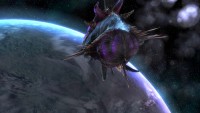
Thomas Targett and Duncan Forgan, research fellows at the Institute for Astronomy, have used the Starcraft game to show how statistical models can predict change in highly complicated systems. They explain their methods below.
Our understanding of the Universe has grown at an incredible rate over the past century. Recent technological marvels like the Hubble Space Telescope, and popular science programmes such as “Stargazing Live” have raised public interest and understanding of astronomy to an all-time high.
However, while cutting-edge discoveries in astrophysics often attract widespread press coverage, a gap in public knowledge often remains when it comes to the complex processes behind the scenes. These progress from an initial idea, to data-gathering, through analysis and testing, and finally to discovery – steps commonly known as the scientific method.
As part of a public outreach project to increase understanding of the scientific method, we used the outcomes of online player vs. player matches in the Blizzard Entertainment computer game StarCraft 2 to develop models of interstellar colonisation. While this project certainly does not represent any real development in our understanding of possible extra-terrestrial life, it does link the more familiar world of interstellar video games with applied science methodology.
We hope that translating parameters from StarCraft 2 into a numerical simulation, which is then explored in a setting based on real-world physics, will open up the processes and concepts of academic paper-writing to a broader audience.
Within the StarCraft 2 universe, three alien civilisations compete for a region of space known as the Koprulu Sector, supposedly situated on the galactic fringe of the Milky Way. These civilisations comprise a human penal colony offshoot group known as the “Terran Dominion”, the insect-like hive-minded “Zerg”, and the technologically advanced telepathic “Protoss”. We transplanted these fictitious civilisations into a model region of space whose properties we set using actual observational data from our own Milky Way.
Our model region has a stellar density, star-formation rate, and other characteristics based on the average values found in our own galaxy. Real-world constraints have been placed on their speed of movement (ie they can’t travel faster than light) before the characters are released into the numerical model. Their subsequent encounters and conflicts are then resolved based upon the “data” collected from outcomes achieved in the online gaming community. It is hoped that this application of combined real and fictional data will illustrate the core properties involved in producing research papers and provide broader understanding of how data are collected and analysed in scientific research.
This is not a peer reviewed scientific research paper, nor has it been submitted to a scientific journal. All work was conducted outside of office hours on personal time.
Further information
Article in Wired: Study Predicts Which StarCraft Race Will Conquer Space
Image gallery
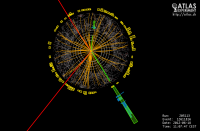
Latest results from CERN further reinforce that the particle discovered last year is a Higgs boson.
Having analysed more data, the CMS and ATLAS experiments at the Large Hadron Collider (LHC) today presented their latest findings at the Moriond Conference in Italy. They find that the particle is looking more and more like a Higgs boson, the particle long-thought to give other particles mass.
"These latest findings reinforce what the ATLAS and CMS teams were reporting in 2012 with regard to the Higgs-like particle and show that we are closer than ever before to completing the Standard Model of particle physics." Dr Victoria Martin, University of Edinburgh ATLAS team.
UK particle physicist and ATLAS spokesperson Professor Dave Charlton from the University of Birmingham said: "The latest results mark a significant step in the measurements of the new boson, and use the full data sample collected so far by the LHC. It has been a great challenge for the experiments to produce such detailed analyses so quickly - it is a testament to the dedication of very many people that we could show them this week. With these results we see both that the decays, and the spin quantum number, of the new particle look like a Higgs boson."
ATLAS at Edinburgh
A team of 20 at the School of Physics & Astronomy is involved with the ATLAS project, and their work contributed to today's announcement. Among them are Chiara Debenedetti, a third-year PhD student in the Edinburgh Particle Physics Experiment group who is currently stationed at CERN for part of her PhD.
"The latest results are the outcome of hard and productive group work. These are amazing times to be a young experimental particle physicist, and I am very honoured to be one! We have the privilege of analysing data containing information that particle physicists have been seeking for a long time, and these data seem to confirm even more that we have seen the Higgs particle. A lot of measurements can be made now, to prove the nature of the particle we have found.
"The Edinburgh ATLAS group, which I am part of, is consistently participating in Higgs searches, and the excitement can be felt even more. Peter Higgs, Professor Emeritus at the University of Edinburgh, postulated his theory and the Edinburgh team is contributing towards proving it! It can be tiring sometimes to have tight deadlines and a lot of pressure, but the results ATLAS has been obtaining pay for all this hard work!" Chiara Debenedetti, third-year PhD student, Edinburgh Particle Physics Experiment group
Further questions raised
The key properties that allow us to say whether or not it is a Higgs particle are the strength with which it decays to other particles and its spin (intrinsic angular momentum) quantum number. Taken with the results on the decays of the particle, if it has spin-zero, as suggested in these latest results, then it is a Higgs particle.
Even then though, the work will be far from over. If the new particle is a Higgs, it could be the Higgs as predicted in the 1960s, which would complete the Standard Model of particle physics, or it could be a more exotic particle that would lead us beyond the Standard Model. The stakes are high. The Standard Model accounts for all the visible matter in the Universe, including the stuff that we are made of, but it does not account for the 96% of the Universe that is invisible to us - the dark universe. Finding out what kind of Higgs it is will rely on carefully measuring the particle's interactions with other particles, and that may take several years to resolve.
STFC pays the UK contribution to the CERN budget as well as supporting UK participation in the four LHC experimental detector projects, including the Higgs boson detectors ATLAS and CMS, and supports the University of Edinburgh Particle Physics Experiment group.
Image gallery
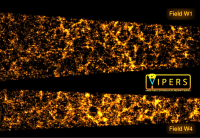
The largest project ever undertaken to map the Universe in three dimensions using ESO telescopes has reached the halfway stage.
An international team of astronomers, including members of the University of Edinburgh, has used the VIMOS instrument on the ESO Very Large Telescope to measure the distances to 55,000 galaxies [1] as part of the VIPERS survey [2]. This has already allowed them to create a remarkable three-dimensional view of how galaxies were distributed in space in the younger Universe. This reveals the complex web of the large-scale structure of the Universe in great detail.
By studying the cosmic web, astronomers can test theories of how the Universe formed and evolved and help to track down the properties of the mysterious dark energy that is making the expansion of the Universe speed up. Mapping how large-scale structure grows with time they can also check whether Einstein’s theory of General Relativity holds precisely, or whether it may need to be revised.
The initial measurement of this growth rate has been led by Dr Sylvain de la Torre and Prof. John Peacock at the University of Edinburgh's Institute for Astronomy, sited at the Royal Observatory Edinburgh. The results show that the strength of gravity had the same value when the Universe was half its present age as it does today; any changes over this period must be less than about 10%, which is the best current limit of its kind.
VIPERS survey
The VIPERS survey is the most detailed map yet of galaxies seen at the epoch when we believe the Universe became dominated by dark energy (as it is today). This happened between five and nine billion years ago — about half its current age of 13.7 billion years. Although it is not yet complete, VIPERS is already delivering exciting science results including a first estimate of the growth rate of large-scale structure at redshifts close to unity and the best census ever of the average number of massive galaxies at this time of the Universe’s evolution.
To mark this milestone the team is submitting this week the first set of papers to be published in scientific journals that describe the survey and the initial results. The results from VIPERS are made public for use by astronomers around the world. The current catalogue of galaxy distances will be released in September 2013.
Notes
[1] The light of each galaxy is spread out into its component colours within VIMOS. Subsequent careful analysis then allows the astronomers to work out how fast the galaxy appears to move away from us — its redshift. This in turn reveals its distance and, when combined with its position on the sky, its three-dimensional location in the Universe.
[2] VIPERS stands for the VIMOS Public Extragalactic Redshift Survey.
Further information about VIPERS, including survey press release images.
Image gallery

The School of Physics & Astronomy at the University of Edinburgh offers an MSc in High Performance Computing (HPC). This well-established programme provides an excellent grounding in HPC technologies and their practical application.
Virtual Open Days
The MSc in HPC team are organising three virtual Open Days this year:
- Monday 18 March 12:00-13:00 GMT
- Thursday 11 April 10:00-11:00 BST
- Thursday 9 May 12:00-13:00 BST
These live sessions in the chat room will allow you to talk to staff and current students about applying for the MSc in HPC, studying in the University, living in Edinburgh and any other aspect of studying with us.
If you are interested in applying for the MSc in HPC, these virtual open days are a good opportunity to:
- Talk to staff from the MSc in HPC
- Discuss career opportunities and financial support
- Meet current students
Scholarships
We are offering two UK/EU Masters scholarships in High Performance Computing for the 2013/14 academic year.
About the MSc
The MSc is taught by experts from EPCC, a supercomputing centre based in the School. EPCC is one of the leading centres of supercomputing expertise in Europe, and it manages an extensive collection of HPC systems including the UK’s national supercomputer HECToR, a Cray XE system with more than 90,000 CPU cores. All our MSc students are given accounts on HECToR and use it extensively for practical exercises and project work.
High performance computing is widely used in science, engineering and industry. Many branches of modern science, such as climate research and nanotechnology, rely on complex computer models, which can only be run on parallel supercomputers. Companies involved in areas such as aerospace and automotive engineering, oil exploration, drug design and genetic sequencing all run computer models on HPC systems.
Furthermore, the parallel programming techniques that were once only applicable to specialist machines are now essential for any software developer who wants to take full advantage of modern multicore processors, graphics processors and computing clusters.
This MSc will equip participants with the multidisciplinary skills and knowledge to lead the way in the field of HPC.
Registration
Find out more
Visit the MSc in HPC website.
msc [at] epcc.ed.ac.uk (Contact us by email).
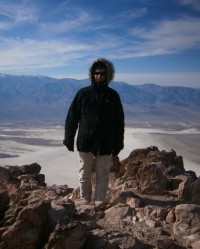
Max Nolte, an MPhys Computational Physics student, is spending his Fourth Year of studies at the University of Washington.
Being a rather ambitious student, I first had trouble finding equivalent courses to what I would have to study in Edinburgh. University of Washington (UW) students only need to declare their major in their third year and so some of the Fourth Year Physics courses seemed too simple for me and I did not want to waste any time on too-easy courses. Thus I decided to take two First Year graduate (PhD) classes.
The first year of Physics graduate school in the US is extremely hard and students get inundated with homework. I managed to pass both classes and learned more than I have ever learned in any course, but this quarter I was wise enough to only take one graduate class. There is a lot more continuous work during the term in American universities than in Britain and the homework counts more. This means more stress during the semester, but also less stress in finals week. In my classes the finals were only worth between 20% and 40%, while the homework accounted for as much as 45% of the grade.
It can be very difficult to get into certain courses (not Physics though), since they fill up quickly or have major-specific restrictions. But there is a wide range of other courses offered and you have the unique chance to take classes you cannot take in Edinburgh. I attended a seminar on Computational Neuroscience and will take a full class in it in my final quarter. And in the Physics department it is possible to conduct undergraduate research (for credits) with some of the professors, which I recommend. I am working on the theoretical X-ray absorption of water this quarter.
Life in Seattle
The University of Washington is a large public university in Seattle and supposedly has America’s most beautiful campus (on sunny days). I love Seattle because it is a big city surrounded by some of the greatest outdoors America has to offer. For an outdoor enthusiast the Pacific Northwest is a paradise. I brought my kayak all the way from Europe and on quiet days it takes me only thirty minutes to drive from my house to the closest whitewater river (that was the reason I applied to the UW in the first place). Mt Rainier (14,411ft), the highest mountain in the State of Washington, is visible from campus on most days. There is plenty of skiing and hiking all year round (I met a guy who went skiing on Mt Rainier in the middle of summer).
The best part of my stay so far has been my Christmas break. I bought a cheap car and went on a 4,400-mile road trip down south. We visited San Francisco, Yosemite, the Redwoods, Las Vegas, Tijuana, Los Angeles, Death Valley and many, many more places.
A few other random, but awesome facts... There is a wide variety of good food in the U-District (University District). Vietnamese Pho is one of my favourites. The gym is bigger than the one in Edinburgh, it is free, the pool is always open and there are cheap classes. There are many sports clubs and societies. Make sure you quickly learn American Football rules to support the UW Huskies (who play to more than 60,000 people at a home game). Seattle is very liberal (they legalised gay marriage and marijuana in Washington) and it is very cycle-friendly.
I can only recommend spending your year abroad at the University of Washington. If you have any doubt, listen to what a wise man once said: ‘Don’t think about it, just do it.’ (Or send me an email).
Study abroad
If you would like to gain experience of studying abroad, the University of Edinburgh can offer you several options. Most students choose to go abroad on their Third or Fourth year of study.
You can apply for a year abroad either through an ERASMUS or an International Exchange programme. More information, including a list of available destinations, can be found on the University International Office's Exchanges page. Or you can contact kristel.torokoff [at] ed.ac.uk (Kristel Torokoff), who coordinates all types of student exchanges in the School of Physics & Astronomy.
Image gallery
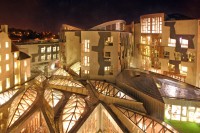
An annual prize honouring the work of Peter Higgs is to be announced by the Scottish First Minister, launching a week showcasing Scottish science.
The new Higgs Prize, which offers the chance to win a trip to CERN, will be open to Scottish school pupils who excel in physics. It will be formally launched by the First Minister and Professor Higgs on Tuesday 5th February.
The science showcase at the Scottish Parliament includes a full-size replica of a section of the LHC tunnel, with students and staff from the School of Physics & Astronomy on hand to explain its work.
Read the full news release below or on The Scottish Government's website.
"As a student at my old school in Bristol, I was inspired by seeing the name of Paul Dirac appear several times on the Honours board. Dirac was awarded the Nobel Prize in Physics for 1933 for his work of inventing anti-matter and in particular the positron. I am pleased to have my name associated with this prize and hope that this will inspire young students of today just as I was myself in the past.
"I know very well how exciting and amazing visits to CERN can be. Rewarding those who have excelled in physics in this way and supporting the next generation of scientists is to be warmly welcomed." Professor Peter Higgs
Higgs Prize kicks off FM science showcase
An annual prize to honour the world-renowned Edinburgh University scientist who has given his name to the Higgs boson is to be announced by the First Minister, launching a week showcasing Scottish science.
The annual Higgs Prize will be open to Scottish school students who excel in physics. It will be formally launched by the First Minister and Professor Peter Higgs at a reception at the First Minister’s official residence on Tuesday.
The Higgs Prize is one of the highlights of a week showcasing Scotland’s scientific excellence, when the First Minister will be promoting the global reputation of Scottish science and the enormous progress being made by Scottish scientists in research and development.
Announcements expected during the week include:
- The Higgs Prize, offering outstanding young school physicists the chance to win a trip to the CERN facility in Switzerland, where work continues on researching the Higgs particle, named after Professor Higgs
- The appointment of 33 new government-funded health fellows, supporting scientific research into conditions such as motor neurone disease
- An official reception to honour the work of the Scottish Science Advisory Council, attended by Professor Higgs.
The First Minister is also expected to make a significant announcement about Scottish life sciences and mark a landmark in Scottish space science.
Mr Salmond said:
“Scottish science in all its forms is going from strength to strength, building on our proud history of scientific discovery – the achievements of Lister, Kelvin, Macadam and many, many others whom every Scot knows of and is proud of.
“Today, Professor Peter Higgs is a household name who is known the world over. His work is celebrated internationally and Scotland is very proud of him.
“The Higgs Prize will be an opportunity for some of Scotland’s brightest young school physicists to see for themselves the cutting-edge of international physics at CERN. I’m delighted that Professor Higgs’ achievements will inspire future generations of Scots.”
Professor Peter Higgs said:
"As a student at my old school in Bristol, I was inspired by seeing the name of Paul Dirac appear several times on the Honours board. Dirac was awarded the Nobel Prize in Physics for 1933 for his work of inventing anti-matter and in particular the positron.
“I am pleased to have my name associated with this prize and hope that this will inspire young students of today just as I was myself in the past. I know very well how exciting and amazing visits to CERN can be.
"Rewarding those who have excelled in physics in this way and supporting the next generation of scientists is to be warmly welcomed."
Professor Sir Peter Knight, President of the Institute of Physics, said,
“We’re delighted that the Government intends to introduce this prize. We will be working with them to establish the best way to identify Scotland’s most promising young physicists.
“With £8.5 billion of the Scottish economy created by physics-based businesses, this prize is recognition of the vital importance of the subject.”
Looking ahead to the week, Mr Salmond added:
“Our scientific expertise earns Scotland billions of pounds in exports from around the world, supports around 170,000 jobs and has scientists from Germany to Japan, India to Australia clamouring to work with our experts in fields such as particle physics, animal health, drug discovery, computer science and biomedical and health informatics.
“As well as the Higgs Prize and a number of other announcements, this week the government will be announcing the appointment of 33 new health fellows to conduct research into medical challenges like treating motor neurone disease, how to use technology to help people with diabetes and how to control internal bleeding. The results of our scientific expertise could benefit millions of people all over the world and potentially translate into market-ready innovations.
“Scotland’s scientists and innovators have made hundreds of discoveries and developments, from penicillin to ultrasound and in fields as diverse as electromagnetism and cloning. Today this tradition of invention is in good hands and I am very much looking forward to a week of showcasing Scottish scientific excellence.”
Image gallery
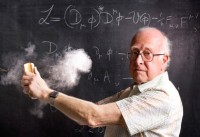
The Higgs Symposium brought together 128 physicists from around the world to hear a series of talks given by a distinguished list of speakers including two recipients of the Milner prize, Nima Arkani-Hamed and Joe Incandela, and a Fields medallist, Sir Michael Atiyah.
The varied topics of the talks underlined the impact of Peter Higgs' work, with leaders in the field describing the developments which are currently pushing the boundaries of our theoretical understanding of particle physics. Other highlights included updates on the current Higgs Boson searches by the CMS and ATLAS experiments, applications in condensed matter and a fascinating historical account by Chris Llewellyn Smith, former Director General of CERN, of the journey from Peter Higgs' original paper to the construction of the LHC.
The Symposium closed with a panel discussion of what the future may hold for particle physics, and the many PhD students who attended were particularly encouraged to take part.
Unfortunately, Peter Higgs was unable to give his scheduled talk on the final day due to ill health. However, he attended and participated in an earlier session.
"We were very fortunate that some of the most distinguished physicists in the world were able to come to Edinburgh to discuss fundamental questions at such a decisive moment in the history of physics." Richard Ball, Higgs Centre Director
The symposium was organised by the Higgs Centre for Theoretical Physics and incorporated the Centre's launch event. It took place in Edinburgh from 9-11 Janury 2013.
Image gallery
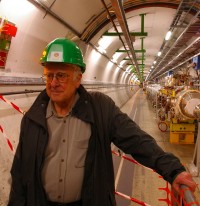
Two members of the School of Physics & Astronomy have been recognised in the 2013 New Year’s Honours List. Peter Higgs, Emeritus Professor of Theoretical Physics, and Honorary Fellow Alan Walker both received honours for their outstanding work.
"My congratulations to Peter and Alan on receiving these great honours. I am delighted by this recognition of their commitment and exceptional contribution to the understanding of physics."
Arthur Trew
Head of the School of Physics & Astronomy
Scientific pioneer
Peter Higgs, Emeritus Professor of Theoretical Physics, has been made a Companion Of Honour in recognition of his services to physics.
The recognition confers no title but is restricted to a select group of 65 for achievements in the arts, literature, music, science, politics, industry, or religion.
While teaching at the University in the 1960s, Professor Higgs proposed a mechanism to explain why the most basic building blocks of the Universe have mass, predicting the existence of a particle known as the Higgs boson. Last year scientists working with the Large Hadron Collider at CERN announced the discovery of a Higgs-like boson.
Bringing science to all
Alan Walker, honorary fellow in the School of Physics & Astronomy, has been awarded an MBE for services to science engagement and science education in Scotland.
Mr Walker officially retired in 2009 but has continued working in public engagement activities. His current project is PP4SS, Particle Physics for Scottish Schools, which takes an understanding of particle physics to the general public as well as schools.
He is part of the University’s Particle Physics Experiment group, which seeks an understanding of the fundamental particles of nature and the forces governing their behaviour. In recent years he has received or shared multiple awards for public outreach totalling in excess of £150,000.
Image gallery
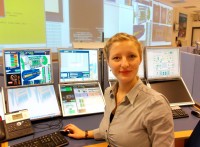
Karoline Selbach is a PhD student in the Particle Physics Experiment group of the Institute for Particle and Nuclear Physics. Here she writes about researching the Higgs boson and explaining the mystery of music.
My particle physics work involves research into the Higgs boson at CERN, the major international research institution close to Geneva in Switzerland. I am part of the ATLAS experiment, which is the largest detector operating underground at the LHC accelerator.
The discovery of a new particle consistent with the Higgs boson (see previous article) was a fundamental breakthrough and marks the start of a new era in particle physics. My aim is to determine the characteristics (eg the mass) of the Higgs boson as precisely as possible. In particular, I’m looking for two Z bosons as the decay products of the Higgs boson. These fundamental neutral particles decay into electrons and muons which our detector can measure extremely well.
Research at CERN
For this rapidly developing work, I am currently fully immersed in the research on-site at CERN (funded by the School of Physics & Astronomy), maximising my contribution to the analysis by writing publications and presenting the results. I won the 2nd year prize for a poster summarising my research.
The current ATLAS detector is performing very well, providing unprecedented insights into our subatomic world. However, to increase the density of particle collisions even further beyond the previous limits, the detector will need to undergo adjustments. To realise this as efficiently as possible, I have also worked on simulating possible detector upgrades of the ATLAS detector. It is a great honour to represent the University in a high-profile international project, discussing and interacting intensely to push back scientific boundaries.
Musical Acoustics
Besides this high-profile research, I also teach undergraduate students at the University of Edinburgh. In my final school years, I studied music in Cologne and worked as a choirmaster and organist for five years. I now deliver a lecture series in Musical Acoustics and run frequency spectrum analysis projects with Music and Physics students. This separate career activity is supported by a Principal’s Career Development PhD Scholarship, which is designed to support research students by integrating research, training and career development.
My teaching brings together a variety of different students who are hooked into Musical Acoustics. Working with students is very inspiring and I enjoy explaining concepts to them. It is very fulfilling to see them evolve by mastering their assignments. In recognition of my teaching work, I was recently made an associate fellow of the Higher Education Academy.
Image gallery
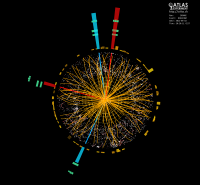
The symposium is an important step in developing links between Edinburgh and India in the physical sciences. Speakers from Edinburgh, CERN and various Indian institutes will discuss exciting developments in particle physics, and it will also act as a wider forum for discussing future collaborations between the University and Indian institutes.
About the event
The purported discovery of a Higgs boson candidate by both ATLAS and CMS possibly completes the Standard Model, but several questions still remain. This is an opportune moment to contemplate High Energy Physics in the Higgs era.
With their diverse (and complementary) expertise in various aspects of High Energy Physics (both experimental and theoretical), groups in India, Edinburgh and colleagues from CERN have initiated a discussion on the implications of the recent Large Hadron Collider measurements and physics beyond the Standard Model. The speakers will include leading particle physicists from the University of Edinburgh, CERN, and various Indian institutions.
Emeritus Professor Peter Higgs, University of Edinburgh will be part of this symposium, further details on this will be available later.
University links with India
The University is involved in several initiatives with Indian universities, research institutes and some government agencies to deepen ties in many areas of science, medicine and humanities.

